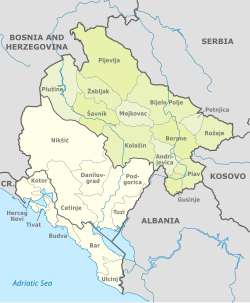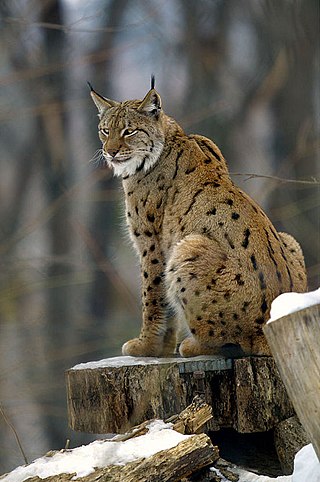Loading AI tools
Region of Montenegro From Wikipedia, the free encyclopedia
Northern Montenegro (Montenegrin: Śever Crne Gore / Ćевер Црне Горе), is one of three statistical regions in Montenegro. It encompasses the sparsely populated mountainous part of Montenegro. It is bordered by Bosnia and Herzegovina to the northwest, Serbia to the northeast, Kosovo to the east, Albania to the southeast and central region of Montenegro to the south.[2][3][4] It comprises thirteen municipalities and is the largest by area.
Northern Montenegro
Śever Crne Gore Ćевер Црне Горе | |
|---|---|
Region in Montenegro | |
 Northern Montenegro | |
| Country | |
| Largest city | Pljevlja |
| Municipalities | |
| Area | |
| • Total | 8,399 km2 (3,243 sq mi) |
| Population | |
| • Total | 152,591 |
| Time zone | UTC+1 (CET) |
| • Summer (DST) | UTC+2 (CEST) |
| HDI | 0.826 (2021)[1] very high · 2nd |
Northern Montenegro comprises thirteen municipalities. Municipalities in Northern Montenegro include: Andrijevica, Berane, Bijelo Polje, Gusinje, Kolašin, Mojkovac, Petnjica, Plav, Plužine, Pljevlja, Rožaje, Šavnik and Žabljak.
The northern region of Montenegro is primarily rural, with a population that tends to be smaller and more dispersed compared to urban areas. It's known for its mountainous terrain, with towns and villages scattered throughout. The largest town by population is Pljevlja, while the largest municipality is Bijelo Polje. Demographically, it includes a mix of Serbs (40.5%), Bosniaks (30.9%), Montenegrins (19%), Albanians (2.2%) and other ethnic groups (7.4%).
| Municipality | Area | Population (2023) | ||
|---|---|---|---|---|
| Km² | Rank | Total | Rank | |
| Andrijevica | 283 | 12 | 3,978 | 10 |
| Berane | 544 | 6 | 25,162 | 3 |
| Bijelo Polje | 924 | 2 | 39,710 | 1 |
| Gusinje | 486 | 8 | 4,662 | 9 |
| Kolašin | 897 | 3 | 6,765 | 7 |
| Mojkovac | 367 | 11 | 6,824 | 6 |
| Petnjica | 173 | 13 | 5,552 | 8 |
| Plav | 486 | 7 | 10,378 | 5 |
| Plužine | 854 | 4 | 2,232 | 12 |
| Pljevlja | 1,346 | 1 | 24,542 | 4 |
| Rožaje | 432 | 10 | 25,247 | 2 |
| Šavnik | 553 | 5 | 1,588 | 13 |
| Žabljak | 445 | 9 | 3,002 | 11 |
Majority of the population is identifying as Orthodox Christian, but also a significant portion are Muslims.
Religion in Northern Montenegro (2023)[5]
List of current mayors and local governments
Democratic Party of Socialists (3)
New Serb Democracy (3)
Bosniak Party (2)
Socialist People's Party (2)
Social Democrats (1)
Democratic Montenegro (1)
Durmitorska Inicijativa (1)
| Municipality | Current Mayor | Party | Local government | Elected | |
|---|---|---|---|---|---|
| Bijelo Polje | Petar Smolović | DPS | DPS-SD-SDP-BS | 2022 | |
| Pljevlja | Dario Vraneš | NSD | ZBCG-DCG-PES! | 2022 | |
| Berane | Vuko Todorović | NSD | ZBCG-DCG-PBS-PCG-UCG | 2022 | |
| Rožaje | Rahman Husović | BS | BS | 2022 | |
| Plav | Nihad Canović | SD | SD-DPS-SDP-BS | 2022 | |
| Mojkovac | Vesko Delić | NSD | ZBCG-DCG-SNP-URA | 2021 | |
| Kolašin | Petko Bakić | DCG | DCG-ZBCG-PES!-SNP-URA-UCG | 2022 | |
| Petnjica | Erol Muratović | DPS | DPS-SD-BS | 2021 | |
| Andrijevica | Željko Ćulafić | SNP | SNP-ZBCG-DCG | 2020 | |
| Gusinje | Sanel Balić | BS | BS-DUA-AA-SD-SDP-SNP | 2020 | |
| Žabljak | Radoš Žugić | DI | DI-ZBCG-DCG-PCG | 2022 | |
| Plužine | Slobodan Delić | SNP | SNP | 2022 | |
| Šavnik | Jugoslav Jakić | DPS | DPS-SD | 2022 | |
There are three national parks in Northern Montenegro: Durmitor, Biogradska gora and Prokletije. Durmitor is part of World Heritage Site.
| Name | Image | Location | Area | Established |
|---|---|---|---|---|
| Durmitor |  |
(Žabljak, Šavnik, Plužine, Pljevlja and Mojkovac municipalities) |
39,000 ha (96,371 acres) | 1952 |
| Biogradska Gora |  |
(Kolašin, Mojkovac, Berane, and Andrijevica municipalities) |
5,650 ha (13,961 acres) | 1952 |
| Prokletije |  |
(Plav and Gusinje municipalities) |
16,630 ha (41,094 acres) | 2009 |

Within Montenegro, the largest concentration of large animals can be found within the north of the country.[6] These higher numbers can be attributed to the areas being mountainous and containing a virgin forest. Brown bears can be found within this area of Montenegro, living within Biogradska Gora national park.[7] There are estimated to be less than 130 individuals living in the wild.[8] These bears are known to reach a weight of up to 200 kg and generally remain docile except for mating season.[9]
Other carnivores such as wolves and Balkan lynxes live in the virgin forest as well, remaining distant from urban areas, this excludes occasional issues occurring from wolves hunting livestock.[10] The Balkan Lynx along with other European species of lynx, remains critically endangered and there have been efforts from environmental organisations to increase protection and prevent extinction of the species.[11] The Balkan lynx has an estimated population of between 40 and 70 individuals in the wild.

Among these larger carnivores is the golden jackal, wild dogs that retain a more slender build and lighter coat than wolves.[12] Northern Montenegro has two predominant species of deer, these are the red deer and the roe deer.[13] Alongside these fauna in the mountains is the Balkan Chamois, a small mountain goat native to the Balkan mountain regions. [14] Domesticated animals include large numbers of rabbits and livestock.[15]
The Durmitor National Park is home to the Musor rock lizard and the sharp snouted lizard. Both species are native to Montenegro.[16]
Seamless Wikipedia browsing. On steroids.
Every time you click a link to Wikipedia, Wiktionary or Wikiquote in your browser's search results, it will show the modern Wikiwand interface.
Wikiwand extension is a five stars, simple, with minimum permission required to keep your browsing private, safe and transparent.